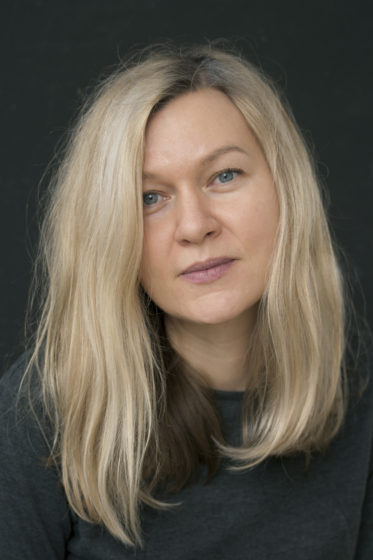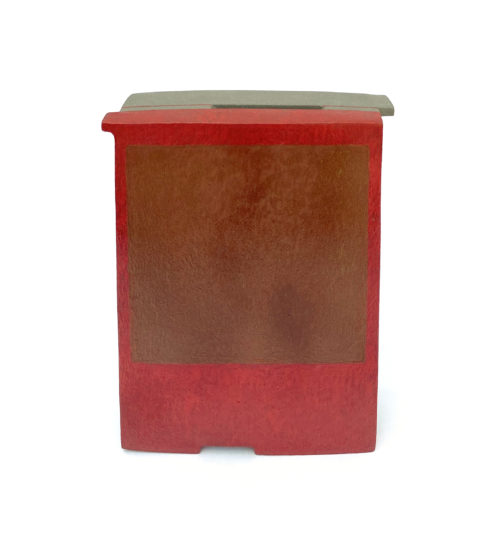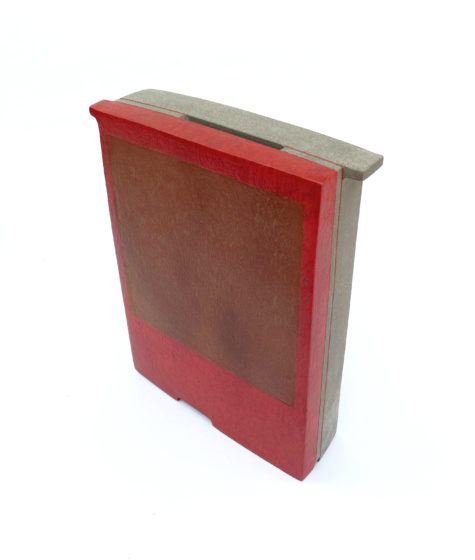Hallway talks with Rūta Šipalytė (Lithuania)

Rothko Centre: Without knowing you personally and judging only by your work, it seems it was made by someone who’s super organised, disciplined and structured, someone whose every thought and deed is kept in apple-pie order. Who knows how to manage her emotions. Is that right?
Rūta Šipalytė: No, I have a tendency to freak out (laughs). If things go wrong, I start stressing. I’m a sensitive soul. My emotions tend to run high, and then I need to have someone talk to me and say: “There, there, it’s alight!” (laughs). So I have these two halves – logical and structured versus volatile and emotional. And I try to balance them out.
With time, I’ve learnt to think that nothing is a full-blown tragedy. I no longer see things in purely black-and-white terms, there is also the golden mean, and it’s not the end of the world. And, more often than not, this balance sits in our heads for us to find. I think we only ever grow up, I mean for real, when we realise (and not because our mum and dad say so, but because we’ve come to it on our own) that there’s a place for everyone under the sun! Actually, the main thing’s to learn to deal with ourselves, to figure ourselves out. Which makes it easier to figure out the others. And the main thing’s to accept all our emotions. And to know how to keep them in check. So I give myself time to weigh things up instead of blurting out what I think then and there. I stand back a bit. And try to conserve my energies. I used to spend way too liberally… Now I’m saving. Because creativity demands incredible strength and focus.
My perfectionism balances things out. When other artists see my work, they say it probably takes incredible patience… I don’t need patience. For me, it’s a meditation, and I revel in it. I caress the ceramic walls, on and on, and make order out of chaos. And it helps me rein in my oversensitive nature. You see, as I grow older, my work becomes more and more impeccable. When I was younger, still a student, I could leave the seams unsmoothed or turn a blind eye on a wobbly line or two… Now I’m in a stage when everything needs to be just so. Slick and smooth (laughs). This is now. We’ll see how it goes.
Take Rothko. He kept his compositions minimalistic. But they had these tiny, minute variations. Such eloquence, achieved with just a few means! He knew how to go deep rather than spread himself thin. In a sense, he was an explorer. One can compare his work to deep-sea diving, going down into the depths.

RC: The symposium takes a fortnight – is the time long enough?
RŠ: Knowing that I’d only have two weeks, I came prepared. So I didn’t have to stress about not making it in time, which was really liberating and allowed me to work with ease, very naturally. But things don’t always go to plan. So one night (which is when I usually get the most exciting ideas and visualise my upcoming images) I was struck by an idea – suppose I transferred a Rothko painting onto my ceramics (smiles). We’d been all given some Rothko spirit at the symposium opening – sealed cans of air from the Rothko Centre, a very original gift. And it tickled me beyond measure – I would open the can, and Rothko’s spirit would come over me, and there I’d be, awash with his unique vision, with how he saw the world. But there’s something more here – the place has Rothko’s originals! And one can draw inspiration from Rothko’s paintings, establish a connection, “touch” his genius and “talk” to the great artist. And make something of one’s own. Such a unique opportunity! And then I thought maybe I’d gone barking mad in the heatwave (laughs). But it all worked out.
RC: How did you become involved with ceramics?
RŠ: Back in school, I was good at mathematics. I actually have a few medals from physics competitions. Literature was harder. I dreamt about studying architecture (my parents are architects). To me, architecture is a special domain where exact sciences and creativity coexist in a symbiotic relationship. I was really drawn to this “two-in-one” aspect. But my mum had other ideas. Those were the Soviet times, which didn’t leave much room for creativity in architecture. And another thing – she said it was a problematic domain for a woman and warned I’d find it hard to break the glass ceiling. She said: “You’ll spend all your life doing menial work for others, make technical drawings and all manner of routine tasks. Then off to a building site to fight with the construction workers who’ll no doubt mess things up. Even given a perfect drawing, they’ll NE-VER E-VER make it right! Why saddle yourself with all this trouble?” As to ceramics, it came into my life through a strange twist of fate. I hadn’t even given it a thought. Then, in Form 4, the teacher read out a list of the things we could do in an after school club as extracurricular activities. I kept listening and listening… And nothing appealed. Until I heard “ceramics”, and it was an instant click. Oh! OK, ceramics it is! From then on, ceramics was always there, in the background, as an aside. Eventually, I brought it up with mum, and she said: “An artist, whether a ceramicist or a printmaker, can do their work from A to Z, from idea to solution. You’re your own boss. No building company will take anything away from you by finishing what you’ve envisioned, and you won’t be dependent on anyone.” And I thought – great! Knowing my pedantic nature, this is perfect!
RC: In your travels around the world, you’ve been able to compare the ceramics of different countries, see some things you’d like to try…
RŠ: You know, in Lithuania, ceramics is more of an applied art. I’ve travelled quite a bit, and I’ve seen how things stand in other countries. Take America or China. It’s an esteemed art there! Actually, Chinese ceramics are out of this world. They have such distinct traditions! Before I went there, my perception of China came from what we see here in cheap mass-market goods. But when I saw their ceramics first-hand in China, I was stunned… Here we simply don’t get to see what they’re making.
RC: Do you share your secrets with other ceramicists?
RŠ: In 2019 in China, during my latest trip there, a local artist (a wonderful scenographer, connoisseur of ancient literature, calligrapher and ceramicist) said a fascinating thing: “You know,” he said, “in ceramics, the glaze is fifty per cent of the work. And no one will tell you the recipe, because then everybody would be making the same type and we’d lose all uniqueness and appeal. So why aim for similarity?” In my teaching work with students, I do the same. I don’t ask for similarity, I don’t ask for a replica. I let them each have their special something. I don’t try to change or bend their nature. I let it work. You know, I once had a student who was “all thumbs”, let’s put it like that. And she kept worrying and fretting… And I told her – relax, it’s your bonus! I could never do the things she did even if I tried. I was positively envious of her work. It had this particular “painterly” feel. So I thought this was something she could use. After all, what makes us interesting is our uniqueness, not our similarities. Coming back to your question, I do share my techniques, and gladly. And people share theirs with me. That’s normal. If it helps someone with their work in the technical sense, why ever not? Then again, I have a few of my personal tricks and secrets, such as the glazes, which I prefer to keep to myself, and that’s also fine, isn’t it? (smiles).
RC: You are also known as the curator of the Teacup exhibition in Vilnius. How do you like working with other artists? Knowing the field inside out, knowing full well how protective creators are of what they’ve made, how do you feel about promoting and publicising the work of others?
RŠ: Initially, it wasn’t even an exhibition in the usual sense of the word. We simply put out an open call for teacups, and ceramicists brought in their work. No selection. Well, and then we thought – if we want quality, we need a juried selection. And we didn’t think of it in terms of promotion. We were just doing our job. Ceramicists have very few opportunities to bring their work out to the public. If we don’t put ourselves out there, we’ll never get out of the fringes. So we did it for ourselves (smiles). After all, we have a vested interest. As one psychologist rightly said, whatever we do, we do it for our own sake. Even if we’re helping someone, we’re implicitly helping ourselves. So no point lying to ourselves that we’re doing it for someone else. No, we aren’t. Somehow or other, we expect a return on the energies we invest into others. We think it’ll do us good, one way or another. That’s human nature. You give some to get some. That’s how it works. The same goes for the exhibitions I make for others – in a sense, I’m also doing it for myself.

RC: In your role as an artist, do you ever have questions or special requests to curators?
RŠ: The greatest clash is always about where my work has been put (laughs). Even here (at the Rothko Centre – ed.), when I came down and saw the exhibition, saw my cube, it hit me how sensitive we artists are and how many meanings we attach to our work. I thought – why have they put it like that? But I didn’t start making a fuss. I just gave myself time, I said – slow down, hold your horses, give it a think. It’s never a good thing to go in head-long. I gave myself two or three days of quiet, not to be a drama queen. Then I had a little chat with the curators and very carefully said I’d envisioned it a little differently. But they had a whole different concept for the show and laid it all out very gently to explain their decision. And I let it be. It wasn’t easy, by far. But I trusted their vast experience and professionalism and gave them the freedom to work. And I have no regrets. So, yes, there’s always this conflict – everybody wants pride of place, front and centre, the best possible spot (laughs).
RC: And what do you expect as a curator from the artists you work with?
RŠ: Please bring only the work you believe in. Only the work that you love. And trust me. Trust me all the way through. Or better don’t come at all. We’ll play it fair. We can negotiate, but no ultimatums.
RC: From idea to the grand finale, which is the key moment in the whole creative cycle?
RŠ: There’s more than one. First, when things fall into place, I mean the birth of the idea. The making as such, not so much – it’s pretty tedious and routine. The second moment is the meditation mentioned above when I’m caressing my objects, smoothing them out. And then waiting for the end result. Will it crack or hold? Will it be what I’d envisioned? At this point, I’m like a woman giving birth, waiting for the result. I mean when it’s still unclear if I’ve gained the upper hand over the material or if it’s got the better of me.
RC: What’s the first thing that comes to mind in hard times when you seem stuck in a rut and need to pull yourself together and get going.
RŠ: Once, I believed in a single truth but now I know better. I know everything is relative. And that other perspectives have the right to exist. It’s such a liberating thought!
